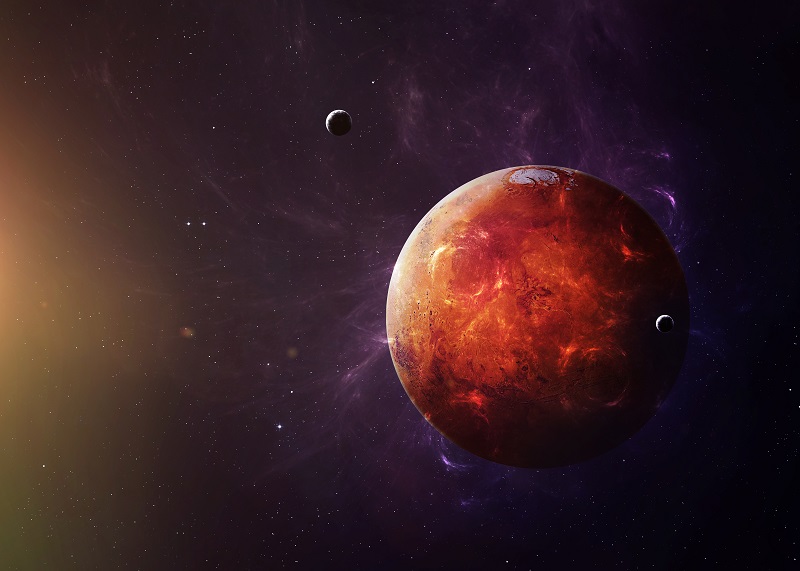The UAE made history on Tuesday evening, 9 February, as the first Arab nation, and the fifth in the world, to reach Mars after the Hope Probe successfully entered the Red Planet’s orbit on, at 7:42pm.
The probe overcame the most critical part of its mission, the Mars Orbital Insertion (MOI) that involved reversing and firing its six Delta V thrusters to rapidly reduce its speed from 121,000 km/h to 18,000 km/h. During the 27-minute critical phase, the contact kept with the probe was kept to a minimum.
Hailing the historic breakthrough, HH Sheikh Khalifa bin Zayed Al Nahyan, President of the UAE, said: “This historic achievement would not have been possible without the persistence and determination to implement the idea that emerged at the end of 2013 by His Highness Sheikh Mohammed bin Rashid Al Maktoum, Vice President and Prime Minister of UAE and Ruler of Dubai, who followed it up closely until its success.”
He also praised the efforts of His Highness Sheikh Mohamed bin Zayed Al Nahyan, Crown Prince of Abu Dhabi and Deputy Supreme Commander of the UAE Armed Forces, in dedicating all kinds of support needed to make the dream come true. “Thanks to both leaders and the team of scientists and engineers behind the project for proving to the world that the UAE is capable of achieving the impossible.”
Sheikh Khalifa bin Zayed hailed the space project, which was the outcome of solid institutional collaboration and a bold vision that aimed to serve mankind and the international science community.
The Hope Probe is the first of three exploration missions to arrive to the Red Planet in February. China and the US are leading ambitious projects to Mars, scheduled to arrive on Feb. 10 and Feb. 18 respectively. Hope probe’s arrival to Mars, after travelling 493 million kilometres in a seven-month journey in space, marks the UAE’s 50th anniversary celebrations.
Now that it has entered the Martian orbit, the Probe will transition to the Science phase– transmitting its first image of Mars back to Earth within just one week.
The Rulers of Dubai and Abu Dhabi celebrated the project as a great success for the UAE, the wider Arab region and the global scientific community following six years of technical and logistical efforts to complete the project. They hailed the team of engineers and scientists behind the project who made the Arab team come true after relentless efforts.
Hailing the success of the mission, His Highness Sheikh Mohammed bin Rashid said: “The Hope probe’s historic arrival to Mars is the greatest celebration of the 50th anniversary of our country. It sets the beginning of the next 50 years with boundless ambitions and dreams.” He added, “Our next accomplishments will be even bigger and greater.”
Sheikh Mohammed bin Rashid added: “Our biggest success is building national scientific expertise who will contribute to the international science community.
“We dedicate our Mars achievement to the people of the UAE and the rest of the Arab world. Our success proves that Arabs can revive the region’s legacy and status in the scientific sphere.”
The most critical phase of the Hope Probe’s entry to the Red Planet’s orbit, the MOI, commenced at 7:30p.m. UAE time.
Previously programmed by the team before the launch, the probe automatically fired its six Delta V thrusters to rapidly reduce its speed from 121,000 km/h to 18,000 km/h. The deceleration burn took 27 minutes until 7:57pm as the probe safely entered the capture orbit.
At 8:08pm, the ground control station at Al Khawaneej received the first transmission from the Hope probe, signalling the success of the mission.
The probe’s entry to Mars’ orbit marks the end of four of the six stages of its space journey that started on 20 July 2020: launch, early operations, cruise, and the Mars Orbit Insertion. The probe is currently entering the ‘transition to science’ phase before it commences the ‘science’ phase to study the Martian atmosphere.
On its first day in Mars, the team restored communication with the probe to ensure its systems remained intact after the dangerous phase it had just passed. For the next three to four weeks, daily contact will be scheduled between the probe and the team back on Earth, enabling a quick turn-around of command sequence uploads and telemetry receipt. The probe will capture its first picture of Mars in the first week of its arrival.
After a period of testing and validation, a series of maneuvers are performed to get the Hope Probe in the correct position to move into the Science Orbit.
The next stage in the Hope Probe’s journey is the transition from the Capture Orbit to an acceptable Science Orbit in preparation for its primary science operations. The rebooting of the probe’s systems can last for 45 days, while the radio signals will take from 11-22 minutes to travel from Hope to earth and back.
The last phase of the probe’s journey is set to begin in April 2020. The probe will officially enter the Science phase to complete the first-ever planet-wide, 24×7 picture of Mars’ atmospheric dynamics and weather daily, throughout all seasons for one full Martian year (687 earth days) until April 2023.
The probe, however, can be used for another two years for additional data collection.
The three science instruments installed on the probe will enable the collection of 1,000GB comprehensive new Martian data, which will be shared for free with over 200 research centers.

